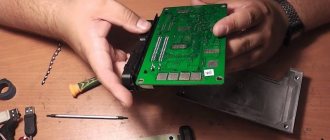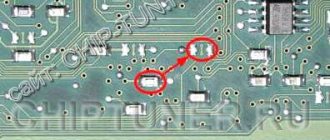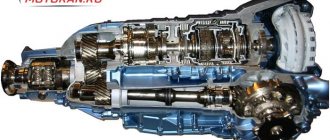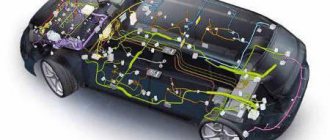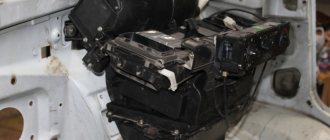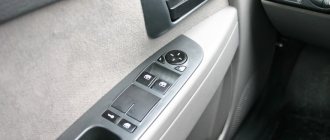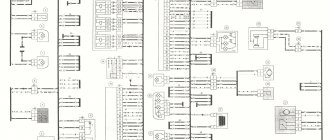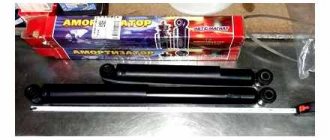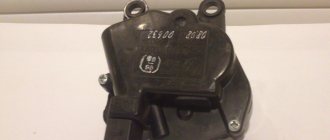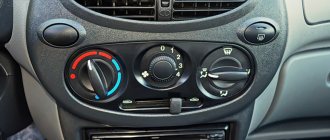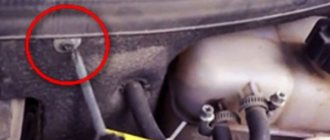Cars admin26.02.2020
In automotive electronics, electronic control unit
(
ECU
) is a general term for any embedded systems that control one or more electrical systems or subsystems in a vehicle.
- ECM (electronic engine management system).
- ECM (Engine Control Module) - engine control module.
- ECU (Electronic Control Unit) - electronic control unit, is a general term for any electronic control unit. (See clause 3.9. SAE J1979[1].)
ECU types are divided into Electronic (ECU) / Engine Control Module (ECM), Combined Engine-Transmission Control Unit, Transmission Control Unit, Brake Control Module, Central Control Module, Central Timing Module, Main Electronic Module, Body Controller, Suspension Control Module , control unit, or control module. Taken together, these systems are sometimes called the car computer. (Technically, this is not a single computer, but several units.) Sometimes one assembly includes several separate control modules.
Some new cars include up to 80 ECUs. Embedded software in ECUs continues to evolve in quantity, complexity, and sophistication [2] . Managing the increasing complexity and number of ECUs in the automotive industry has become a key challenge.
Electronic control unit systems [3] [edit | edit code]
- ABS (Anti-lock braking system) - Anti-lock braking system.
- ACU (Airbag Control Unit) - Airbag control unit.
- Amplifier (Sound amplifier).
- BCM (Body Control Module) - controls door locks, electric windows, courtesy lights, etc. — On-board electronics controller.
- Brake Control Module (ABS or ESC) - Brake system control module.
- CCP (Climate Change and Prediction) - Climate control control unit.
- CCU (Convenience Control Unit)
- CD Changer (CD Player).
- Cellular Telephone (cell phone).
- Chime (Sound Alarm System).
- CV RSS (Continuously Variable road sensing suspension) - Suspension with continuously variable shock absorber stiffness).
- DCU (Door Control Unit) - Door control unit.
- Digital Radio Receiver.
- DIM (Dashboard Integration Module) - Integrated dashboard module.
- Door Module(s)
- Driver Door Module.
- Driver Information Center - (Driver information system).
- Dual Zone HVAC - Dual zone climate control.
- E&C Bus (Multiplex bus for comfort systems).
- ECM (Engine Control Module) - Engine control module. (Not to be confused with electronic control unit, the general term for all these devices.)
- ELC (Electronic level control) - Air suspension with electronic level control of the body position).
- EPS (Electric power steering) - Electric power steering.
- ESP (Elektronic Stability Program) - Electronic stability control.
- ETACS (Electronic Timing And Control System) - Electronic full vehicle control system
- Head Up Display Controller.
- HMI (Human Machine Interface) - (Board Computer) - On-board computer.
- HPS (Hydraulic power steering) - Hydraulic power steering.
- HVAC (Heating, Ventilation and Air Conditioning) - Climate Control.
- IPC (Instrumental Panel Cluster) - Electronic instrument cluster.
- Memory Mirror Module (Memory mirror controller).
- Memory Seat Module (Seat controller with memory).
- Multifuncton Alarm Module - Multifunctional security module.
- Navigation Radio (Radio with navigation system).
- OnStar (Navigation system).
- Passenger Door Module.
- PCM (Powertrain control module) A combined control module consisting of an engine control unit (ECU) and a transmission control unit (TCM).
- Personalization (Authorized Access System).
- PPS (Passenger Presence System) - Passenger presence monitoring system.
- PSCU (Electric Power Steering Control Unit - Generally this will be integrated into the EPS powerpack.
- Radio (Radio receiver).
- RCCP (Rear Climate Change and Prediction) - Rear climate control panel.
- Rear Aux Climate Module - Additional rear climate control system.
- Rear Seat Entertainment.
- Remote Function Actuation.
- RIM (Rear integration module) - Integrated rear cabin module.
- RSS (Road Sensing Suspension) - Suspension with variable shock absorber stiffness.
- SIR (Supplemental Inflatable Restraint) - Additional (Airbags) airbags.
- SCU (Seat Control Unit)
- SCU (Spee
- Serial Data Gateway (Multiplex Bus Controller).
- TCM (Transmission control module) - Transmission control module.
- TCS (Traction control system) - Traction control system.
- TCU (Telephone Control Unit) - Telephone control unit.
- VTD (Vehicle Thief Deterrent) - Security alarm.
Popular car electronic computer malfunctions
Traditionally, the ECU is a fairly reliable device in modern cars. However, depending on the quality of operation of the car or external factors, the system may malfunction. Popular reasons for the failure of such electronics are the following factors:
- significant heating of the device;
- a short circuit has occurred in the system;
- penetration of moisture into the device body, connectors or exposed areas;
- external mechanical damage to equipment;
- emerging corrosion processes.
Various characteristics help to indirectly identify malfunctions in the operation of electronics, for example, the motor fails even though the sensors and other power plant systems are absolutely functional. Proper operation directly depends on the quality of voltage in the entire on-board system of the vehicle.
Failure of a car computer leads to unstable operation and failures in different modes of the internal combustion engine. Sometimes such an event is characterized by a complete blocking of the power plant. In this case, a “check” lights up on the instrument panel. It will not be possible to simply reset such an error, and if this happens, the cause of the problem will not disappear, and the corresponding indicator will soon appear again.
In such a situation, it is necessary to diagnose the condition of the ECU. We recommend completely replacing the failed board. It is believed that you can carry out independent repairs of the microcircuit, which will cost less than installing a new product. However, careful monitoring of performance and elimination of all possible faults is required, which is not always available to car enthusiasts.
In automotive electronics, electronic control unit
(
ECU
) is a general term for any embedded systems that control one or more electrical systems or subsystems in a vehicle.
- ECM (electronic engine management system).
- ECM (Engine Control Module) - engine control module.
- ECU (Electronic Control Unit) - electronic control unit, is a general term for any electronic control unit. (See clause 3.9. SAE J1979[1].)
ECU types are divided into Electronic (ECU) / Engine Control Module (ECM), Combined Engine-Transmission Control Unit, Transmission Control Unit, Brake Control Module, Central Control Module, Central Timing Module, Main Electronic Module, Body Controller, Suspension Control Module , control unit, or control module. Taken together, these systems are sometimes called the car computer. (Technically, this is not a single computer, but several units.) Sometimes one assembly includes several separate control modules.
Some new cars include up to 80 ECUs. Embedded software in ECUs continues to evolve in quantity, complexity, and sophistication [2] . Managing the increasing complexity and number of ECUs in the automotive industry has become a key challenge.
ECU failure [edit | edit code]
The main symptoms of ECU failure are refusal to start the engine, a constant indication of an error in engine operation that cannot be cleared. ECU failure is quite rare and you can never predict exactly when it will happen. To identify and confirm ECU failure, manufacturers and repair facilities must perform a number of the following [4] checks:
- evaluate the quality of the block assembly
- Check electronics
- Carry out fractography
- Check for overheating
- check for corrosion and destruction
Meeting these conditions in testing will prevent damage in the future and increase productivity.
Engine control modules [ edit | edit code]
">Controllers>edit code]
- Bosch M1.5.4 (55 Pin) (1.45/1.5l., 8kl.) (Russia-83) Simultaneous injection.
- Bosch M1.5.4N (55 Pin) (1.5 l., 16 kl.) (Euro-2) In pairs - parallel injection. / Phased injection.
- Bosch MP7.0HFM (55 Pin) (1.5/1.7l.,8/16kl.) (Euro-2/3) In pairs - parallel injection./Phased injection.
- Bosch M7.9.7 (81 Pin) (1.5/1.7l.,8/16kl.) (2003 - 2007) (Euro-2/3) In pairs - parallel injection / Phased injection.
- Bosch M7.9.7+ (81 Pin) (1.5/1.7l.,8/16kl.) (2005 - 2011) (Euro-3) Phased injection.
- Bosch ME7.9.7 (Euro-3) Phased injection.
- Bosch ME17.9.7 (Euro-3) Phased injection.
">Controllers [ »">edit | »»>edit code ]
- Delphi MT20 (Euro 3)
- Delphi MT80 (Euro 3/4/5/6) [5]
- Delphi MT92 (Euro 3/4/4/6) - Gasoline Direct injection (GDi).
- Delphi AC Delco E39/E39A (Euro 2)
- Delphi AC Delco E73
- Delphi AC Delco E78
- Delphi AC Delco E83
- Delphi MR140
">Controllers [ »">edit | »»>edit code ]
- GM EFI-4 (24/32/32 Pin) (USA-83) - Single injection. [6]
- GM ISFI-2S (24/32/32 Pin) (1.5 l. 8/16 cells) (USA-83/Euro-2) - 8 cells. in pairs - parallel injection, 16kl. phased injection
- GM ITMS-6F (Euro-2) - In pairs - parallel injection.
">Controllers [ »">edit | »»>edit code ]
- Simtec 70 (Euro 2) Phased injection.
- Simtec 71 (Euro 3) Phased injection.
- Simtec 75.1 (Euro 4) Phased injection.
- Simtec 75.5 (Euro 4) Phased injection.
- Simtec 76 (Euro 2/3)
- Simtec 81 (Euro 5) Direct injection.
">Controllers [ »">edit | »»>edit code ]
The January xxx and Mxx controllers were produced at two different factories - Itelma (The first element in the firmware designation is the letter “I” in the ECU marking) and Avtel [7] (The first element in the firmware designation is the letter “A”.
- January 4 (24/32/32 Pin) (1.6l., 8kl.) (Russia-83) In pairs - parallel injection. (The label contains the designation of the debug version “Kvant”.)
- January 4.1 (24/32/32 Pin) (1.5l., 8/16kl.) (Russia-83) (1998) Phased injection. (The label contains the designation “Quantum”.)
- January 5.1 (55 Pin) On the label: NPP AVTEL LLC, TU 4573-004-45886863-99, .
- January 5.1.1 (55 Pin) On the label: NPP AVTEL LLC, TU 4573-004-45886863-99, . (1.5 l., 8 cells) (Euro 0) Simultaneous injection.
- January 5.1.2 (55 Pin) On the label: NPP AVTEL LLC
">Controllers [ »">edit | »»>edit code ]
- VS 5.1 1411020-02 (1.45l, 8kl.) (Russia-83) Simultaneous injection.
- VS 5.1 1411020-72 (1.5l, 8kl.) (2003- ) (Russia-83) Simultaneous injection.
- VS 5.1 1411020-62 (1.5l, 8kl.) (2003-) (Euro 2) Pair-parallel injection.
- VS 5.1 1411020-42 (1.5l, 16kl.) (2003-) (Euro 2) Phased injection.
- VS 9.2 (Euro 4) Used diesel engine UAZ 3151 (Hunter).
- T11183 (Euro 2/4) (1.6l, 8kl.)) [8] Pair-parallel injection.
- T11186 (Euro 4) (1.6l, 8kl.)
- T11194 (Euro 3) (1.6l, 16kl.)
- T21067 (Euro 3) (1.6l, 8kl.)
- T21114 (Euro 2/3) (1.6l, 8kl.)
- T21116 (Euro 4) (1.6l, 8kl.)
- T21124 (Euro 2/3) (1.6l, 16kl.)
- T21126 (Euro 3/4) (1.6l, 16kl.)
ECU in a modern car
The first thing to start with is terms. The ECU is the “brains” of the car or the electronic control unit. Many people know it as a controller. It really is the brain of the machine. Without this block, all other elements and mechanisms simply turn into lifeless trash, a huge amount of plastic, wires and microprocessors.
The electronic unit receives data from sensors. The information is then processed using special algorithms. Next, it sends special commands to the actuators. There is an ECU even in models from AvtoVAZ. There are also sensors - for example, oxygen, coolant temperature, speed. What can we say about modern foreign cars?
This is the electronic control unit of the ECU. In simple words, this is a smart device that keeps under control all the processes that take place in cars every second. Up to a thousand different signals are processed per second.
Principal purpose
ECU (English Electronic Control Unit) is a general term. It serves to designate blocks that control:
- engine systems;
- modes of the transmission unit, including all-wheel drive (if equipped);
- pendant;
- brake system, brake assistants;
- microclimate.
The central synchronizing unit is also included in the concept of the ECU.
An on-board computer, or the brains of a car, is a term that does not reveal the full variety of work done by electronics.
Performed tasks
During operation, the ECU continuously receives information from various sensors, recognizes signals, and issues commands based on the analysis results.
Thus, the control unit of an internal combustion engine (ICE) collects data on several parameters of engine operation at once. These include:
- crankshaft rotation speed;
- temperature in the cooling circuit;
- level of harmful substances, oxygen in exhaust gases;
- instant fuel consumption;
- power, torque.
This information allows you to recognize the main situations and, taking into account the developed algorithms, give a command to change the operation of individual elements of the unit.
The main processes for which the engine control unit is responsible:
- Ignition, gas distribution. Taking into account the driving mode and engine temperature, it is necessary to change the filling time of the cylinder working chamber and supply an energy pulse on time. Using a similar principle, in more advanced designs one or more cylinders are turned off and the engine is stopped in the “start-stop” mode.
- Control of fuel equipment and related devices. A biturbo engine does not always operate at maximum efficiency. Only when necessary, the multi-stage air blower is activated and fuel is sprayed into the working chamber and partially into the discharge pipe. Fine-tuning the engine's operation is only possible using electronic mechanisms.
Other systems work on a similar principle..
This is interesting: How to remove the front bumper on Priora 2
What does the controller control?
We can list several main sensors from which information is collected. These are engine temperature, ambient temperature, lambda probe, fuel level and idle speed. Also, many cars have ABS sensors, brake pad wear and other sensors responsible for safety.
Individual elements control the speed of movement and the position of the electronic gas pedal. There is a crankshaft position sensor. The ECU also controls the operation of the cooling system and climate control. The unit monitors the correct operation of the brake system.
Naturally, this is not the entire list of sensors. This is a kind of standard set that is found on any more or less modern car. The VAZ-2170 ECU has approximately the same set of functions. We talked about sensors, but we also need to talk about actuators.
This is a throttle position regulator, an injector, an ignition system. The ECU also controls the distribution phases, the combustion temperature of the mixture and is able to maintain it. The unit analyzes the composition of exhaust gases. It regulates the lighting, controls the power windows, all heating, and the operation of robotic and automatic gearboxes.
This is just the minimum of what the average ECU can do. We already know what it is, so let’s move on - it will be interesting. On cars of a higher class there are many more sensors and devices.
In fact, the ECU is a small unit that keeps the operation of the entire car under constant control. Every system is controlled by this computer. People who are far from the automotive world and novice drivers think that the ECU looks like a laptop (after all, a computer?). But this is not true at all. The control unit is manufactured in a slightly different form factor.
Decoding error codes using the example of VAZ 21074
If the injector's brains have detected a malfunction in the engine's operation, this will be signaled by the illuminated "check engine" light. It is impossible to understand what kind of malfunction occurred based on this alert. To more accurately determine the breakdown, you need to connect a diagnostic scanner to a special connector. With its help, an error log is read from the ECU memory, which can be decrypted using reference books for a specific car. So, for example, for the VAZ 21074 the most common errors are:
- Air sensor malfunction;
- Non-optimal combustion mode of the fuel-air mixture. As a result, exhaust gases have increased toxicity. The lambda probe can generate this error, for example, if there are vapors of unburned gasoline in the exhaust;
- A driver check of the injection engine control module is required;
- Problems with receiving information from the temperature sensor;
- The composition of the combustible mixture does not correspond to the operating mode of the engine. The reason for this could be, for example, dirty injectors;
- Incorrect determination of the moment of detonation in engine operation;
- No throttle position data available. In addition to damage to the reading element itself, a break in the information loop is possible;
- The motor temperature is above the operating range;
- Slow response of the vehicle alarm system.
When reading errors, the scanner only indicates the suspected location of the malfunction, but cannot indicate the cause of the breakdown, so after receiving the code it is important to interpret it correctly. If there is insufficient understanding of the operation of injection engines and fuel systems, a situation may arise when the car owner, having incorrectly deciphered the error log, begins to repair a working part of the car.
What does the ECU look like and what does it represent?
The control unit is manufactured in a variety of housings. Often these are plastic or aluminum bases. For example, the VAZ-2172 ECU is made in a plastic case. Most foreign cars have a metal body. The material largely depends on the location of the block. So, if on models from AvtoVAZ the unit is installed in the passenger compartment, then it is made of plastic. If it were installed under the hood, it would be made of metal.
But the housing is not the entire ECU. Inside the case there is an electronic board. This is the ECU. We already know roughly what it is. Two connectors are brought out from the board - this is the so-called CAN bus. Wires from all sensors and actuators are connected to these connectors. It should be noted that some units are also equipped with a connector for updating firmware, as well as an OBD-II diagnostic output. Like any computer, this one also sometimes “glitches”. Failures also occur in sensors. Using the diagnostic connector, you can read the error codes of the VAZ ECU and then it will be easier to repair the car. You no longer need to search for breakdowns manually.
ECU chips are subject to quite strong heating. That's why their bodies have ribs. The latter perform the function of radiators, removing excess heat. If you take and look at the dismantled block, then in appearance the block is a small box measuring 15 by 10 cm, its thickness is no more than a centimeter.
Where is?
I have already touched a little on the location of this block. BUT now I want to repeat it a little. There are only two main locations:
- Vehicle interior . This could be under the panel; for example, in our VAZs it is located in the area of the heater radiator. Also under the rear seat, on many business class foreign cars it is located there. I also read somewhere on the Internet that it could be in the trunk of a car.
- Under the hood . NOT the best place, because there is mud, snow, water and other delights. Usually located next to the battery (like mine), or next to the fuse box. As a rule, such ECU units are well sealed.
So finding it is not that difficult. Even an ordinary driver will be able to disassemble part of the instrument panel (as a rule, it is not so difficult to remove), or look under the hood of his car. If you see a box with two cables coming from it, this is the ECU. But I don’t advise you to get into it - if you don’t understand anything, it’s better to trust the professionals.
ECU from inside
If you open the block, you can see a fairly large board. Inexperienced car owners, and indeed inexperienced computer users in general, will confuse it with a computer motherboard. We will not understand its structure thoroughly, but will briefly talk about the main components.
Let's focus on ECU memory. What it is? There are several types of memory. PROM is a programmable constant where the developers have included the necessary algorithms for the operation of the engine and other systems. RAM is random access memory, which is necessary for working with intermediate information. It is processed in real time. EPROM is an electronic, reprogrammable memory. Used to store temporary data.
Software
Functional software is the most important. After all, it is through it that information from sensors is read and analyzed, and commands are also sent to actuators.
The modules monitor the received data for errors, if any can be detected. The software tries to correct errors if possible. If the error cannot be corrected, then Check Engine, etc. is displayed on the on-board computer display. There is no need to remember all the ECU errors. Their decoding is different for all types of cars. For example, on a Lada Priora, code P0353 indicates an open circuit in the ignition coil of the 3rd cylinder.
Dismantling
Removing the control unit is very simple. It is enough to unscrew the holding bolts and disconnect the cables. Naturally, before this work you should remove the negative terminal from the battery. On some car models, disassembly of the dashboard is required. Often the block is located on the side of the stove or under the glove compartment.
Finding out if the unit is working is very simple. In half the cases, the car simply will not start. It is also possible that all systems will be blocked, all locks will open, etc. In other cases, engine malfunctions may occur. So, on some cars the speed may fluctuate and failures may occur. The engine may not start at all. There are errors that cannot be removed using software. It should be noted that the ECU is a fairly reliable unit. Therefore, if you don’t specifically “heat” it, the unit will work for a long time and properly.
How do breakdowns happen if the unit is reliable? It's simple - all it takes is a short circuit or moisture getting on the board. Also, the ECU does not like physical influences and corrosion.
Problems that occur in the module
The reasons why a car may be left without brains most often arise from the fault of the car owner. For example, an attempt to rewrite the software during chip tuning may end in failure if the car enthusiast has chosen the wrong software. Also causes of ECU failure are:
- Poor location of the control module. For example, in VAZ 2113 - 2115 cars the ECU is installed next to the heater radiator. In addition to the thermal effect, the unit can be flooded with coolant, after which the car will be left without brains;
- Poor contact between the terminals and the generator or battery. This causes surges in the vehicle's on-board voltage. The ECU is protected from voltage surges, but prolonged exposure can damage the unit;
- The occurrence of EMF in the primary winding of the coil leads to breakdown of the transistors of the electronic control unit. Electromotive force usually occurs due to poor spark plug contact or increased internal resistance of high-voltage wires.
To determine the malfunction, you need to read the error log stored in the brains of the injector. There is a special diagnostic connector for these purposes. Its location depends on the specific car model. For example, in VAZ cars with a high panel, the diagnostic connector is located inside the center console.
Repair, replacement
It’s hard to say whether to repair the ECU or replace it. Sometimes the controller burns out completely, so much so that it can no longer be repaired. A new unit needs to be installed. And this is not so cheap - the average price is from 15 to 40 thousand rubles.
But if the error can be eliminated by replacing one or two microcircuits, then repair is advisable. If a track on the board has been eaten away by corrosion, this can also be restored.
A few words about (firmware) CHIP tuning
Of course, I already have an article about this process, read it . But now I’ll repeat myself a little. CHIP tuning is a software improvement of the standard “firmware” (microprogram), which is installed from the factory. Now there are a lot of companies that do this type of work, but it is worth remembering that the firmware must also be original or adapted for your car. The new program will increase power, improve smoothness, and also make fuel consumption more economical. By the way, the firmware also regulates the operation of your automatic transmission, shifting, etc.
I will say this, with the help of CHIP tuning you can achieve an increase in power of 10% and sometimes even higher, if we say, remove the catalyst .
This is how the article turned out, now watch the short video.
This is where I end, read our AUTOBLOG, it will be interesting.
Similar news
- What is wheel alignment
- Parktronic, what is it?
- What is ESP?
Add a comment Cancel reply
What controls
For everyone, the decoding has already become quite clear and known. It became much easier to understand the meaning of the device even after this step. Now you know what this abbreviation is and what the ECU we are considering stands for. Quite often, only the abbreviation is used in technical documentation, since there is no point in reminding motorists of its meaning every time. The ECU can be called briefly using an abbreviation, the full concept of an electronic control unit, or simply a controller. The essence of this will not change in any way. It is much more important to find out what this ECU is and where it is located in the car.
Car engine controlled by ECU
In fact, the block is the brains of a modern car, without which we would get a pile of metal with all sorts of sensors, wires and electronic devices that are in no way connected with each other.
The ECU is almost constantly in operating mode, since it receives a huge amount of information from various sensors. The unit processes this data using the algorithms provided in its program, after which it sends command signals to the so-called actuators. The unit forces pumps, ignition systems, injectors and much more to operate in the appropriate mode.
As a result, it turns out that the unit acts as a manager for all electronic processes provided in the vehicle. And this is from the basic operation of headlights to the control of security systems.
There is a fairly extensive list of sensors from which information first goes to our ECU, and then, after being processed, the unit itself sends commands to actuators, depending on the results of the analysis of the information received.
Among the main sensors that depend on the controller, there are several. They are responsible for:
- motor temperature;
- idling;
- fuel supply;
- oxygen supply;
- ambient temperature;
- anti-lock braking system;
- stabilization system;
- anti-skid;
- speed;
- current throttle position;
- accelerator pedal pressure level;
- crankshaft;
- braking system;
- coolant level;
- brake fluid level;
- voltage in the on-board network;
- hydraulic booster;
- electric power steering;
- air conditioner;
- heating, etc.
But only the basic set is listed here, which is found on almost every modern vehicle. On more advanced machines with rich equipment, the list increases significantly.
Having processed the received information, the controller or brain of the car sends commands to various executive units, systems and mechanisms. This allows you to make changes to the work:
- throttle valve;
- air supply systems;
- ignition;
- valve timing;
- air conditioning systems;
- exhaust system;
- lighting;
- window lifters;
- heating;
- Automatic transmission, etc.
But even here we are talking exclusively about the minimum set typical for the basic configuration of an inexpensive foreign car. Increase the equipment or buy a more modern and advanced car with more electronics, and the ECU will send commands to a number of additional systems, mechanisms and devices.
For many, it is surprising that one small unit can do such a complex job. Moreover, it does this constantly, without interruptions, while simultaneously processing a huge amount of information.
Due to its wide functions and capabilities, some believe that the ECU should look like a computer, laptop or tablet and have an impressive size. The only exception is the lack of a screen. But in reality, everyone is even more amazed when they see the real form factor of this control unit.
What does it look like
In fact, you already know what an ECU is in any modern car. This is the control and command center of the entire vehicle. All electronics used are connected to one unit. She is required to report to the ECU every second and sometimes even more often. At the same time, the controller itself, analyzing the received data, can correct the operation of the systems and the entire machine, transmitting the necessary command signals to the actuators.
External view of the Bosch engine ECU
Now it’s worth looking at the block simply as a component of the car. This is a small device that is housed in a special housing. The material used for the housing is plastic or metal, most often aluminum due to its resistance to corrosion.
The main advantages and disadvantages of the ECU
Despite having many advantages, electronic modules also have disadvantages.
Advantages of the ECU
Advantages of the devices:
- the ability to optimize the dynamic parameters of the internal combustion engine;
- reduction of fuel consumption with proper adjustment of the air-fuel ratio;
- ease of starting the power unit - the module quickly adapts the engine to operate under different conditions, for example, when idling;
- when installing an ECU in a car, the car owner no longer needs to manually adjust the operating parameters of the internal combustion engine;
- increasing indicators of environmental cleanliness with proper regulation of the volume of harmful substances in exhaust gases.
Disadvantages of the ECU
Disadvantages of electronic modules:
- high price for component elements if there is a need to repair the module;
- If there is a problem, the unit is often beyond repair and must be replaced entirely;
- the need to operate expensive and complex equipment to check the module; sometimes qualified technicians are required for diagnostics;
- increased requirements for on-board power supply reliability parameters - power surges can lead to ECU failure;
- the need to use only high-quality fuel when refueling the car.
The Avto-blogger channel spoke in detail about the features and disadvantages of electronic modules.
